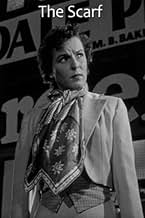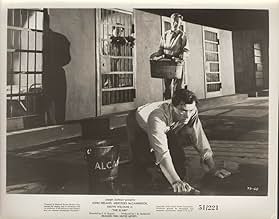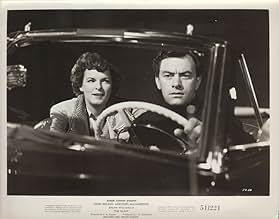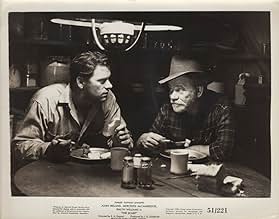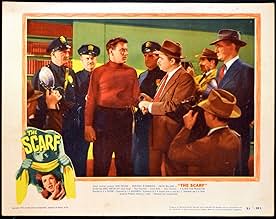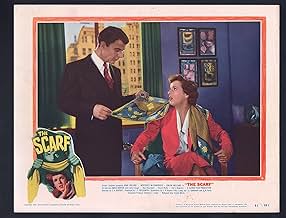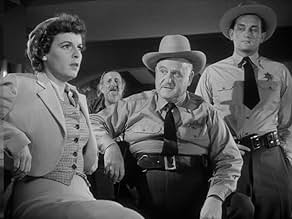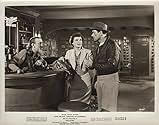Ajouter une intrigue dans votre langueA man believed to have murdered a woman, escapes from the insane asylum to find if he was the one who actually killed her using the scarf she was wearing.A man believed to have murdered a woman, escapes from the insane asylum to find if he was the one who actually killed her using the scarf she was wearing.A man believed to have murdered a woman, escapes from the insane asylum to find if he was the one who actually killed her using the scarf she was wearing.
- Director
- Writers
- Stars
- Prix
- 2 victoires au total
David Bauer
- Level Louie
- (as David Wolfe)
Iris Adrian
- Floozy
- (uncredited)
Richard Alexander
- Barfly
- (uncredited)
Barry Brooks
- Hospital Prison Guard
- (uncredited)
King Donovan
- Piano Player
- (uncredited)
John Frederick
- Deputy
- (uncredited)
Frank Hagney
- Floozy's Boyfriend
- (uncredited)
Frank Jaquet
- Town Sheriff
- (uncredited)
Frank Jenks
- Tom
- (uncredited)
Chubby Johnson
- Feed Store Manager
- (uncredited)
Tom Kennedy
- Asylum Inmate
- (uncredited)
Avis en vedette
I saw this film while catching up on classic film noir. I was not expecting much--a little B film. And Maltin's summary did nothing to encourage my expectations. However, I found a solid film here.
It has an intellectual patina, which is surprising in an American film from 1951. The characters actually talk about some serious issues, though this talk may not be agreeable to some viewers. New York Times critic Bosley Crowther, in his review of this film (April 23, 1951), wrote that the film "expresses in several thousand words of dialogue. . .perhaps the least measure of intelligence or dramatic continuity that you are likely to find in any picture, current or recent, that takes itself seriously." Obviously, I don't agree.
The film is well cast and acted by an unusual combination of actors: John Ireland, Mercedes McCambridge, Emlyn Williams (the English actor), and Ezra Thompson in the leads.
Even the song, "Summer Rains," sung by McCambridge, is perfect for this film: a solid, torchy number in a minor key. Why wasn't this recorded by Peggy Lee or Julie London or Chris Connor? It would have suited them fine.
I was taken totally by surprise by John Ireland's appearance here. This is the only film I've seen Ireland in in which the man is hot, sexy, alluring--certainly not words that one would normally use in discussing John Ireland's appearance. A good part of this is due to cinematographer Franz Planer, though Ireland got some help from his costumes, too. Planer is careful to light Ireland's face in a flattering way, and Ireland just shimmers in the shadow and light of the sharp black and white photography. There is one close-up of Ireland that is stunning--a pure Hollywood glamour shot in the Hurrell tradition: Ireland is sitting at a table in a bar. He has his hat cocked so that it hides one of his eyes and throws half of his face into shadow. He slowly looks up at the camera. This kind of glamour close-up was usually reserved for top female stars in Hollywood's Golden Era, but Planer gave it to Ireland here.
In addition to these shots of Ireland's face, which make him truly handsome, he is wearing throughout most of the film a white t-shirt that makes clear that even at age 37 he still had a nice, in-shape body--nice chest, nice biceps. (Ireland started his career performing as a swimmer in a water carnival.) Later on Ireland is shown wearing a black turtleneck sweater that compliments his chest and a black leather jacket. And who put those pants on Ireland? They aren't expensive--just cheap cloth, but in every scene, those pants just hug the long, lean lines of his butt and his upper thighs. Hot stuff!
I found the film totally absorbing, so much so that I got through the final movie hokum scene which reveals the villain. I can see how some would react negatively to this film. For instance, critic Manny Farber writing in The Nation (May 26, 1951) called "The Scarf" "a disjointed, monstrously affected psycho-mystery freak show." Ha! That comment could be considered a reason to see this film today, Manny.
There is a satisfactory plot summary and commentary on this film on pages 152-3 of Robert Ottoson's The American Film Noir (Metuchen, New Jersey: The Scarecrow Press, 1981). However, Ottoson misidentifies Dr. David Duncan as "the prison psychiatrist." He is, in fact, a psychiatrist in private practice and a friend of Cyrus Barrington. Ottoson says that actor Lloyd Gough plays "the detective." Gough plays Dr. Gordon, who is the prison psychiatrist.
It has an intellectual patina, which is surprising in an American film from 1951. The characters actually talk about some serious issues, though this talk may not be agreeable to some viewers. New York Times critic Bosley Crowther, in his review of this film (April 23, 1951), wrote that the film "expresses in several thousand words of dialogue. . .perhaps the least measure of intelligence or dramatic continuity that you are likely to find in any picture, current or recent, that takes itself seriously." Obviously, I don't agree.
The film is well cast and acted by an unusual combination of actors: John Ireland, Mercedes McCambridge, Emlyn Williams (the English actor), and Ezra Thompson in the leads.
Even the song, "Summer Rains," sung by McCambridge, is perfect for this film: a solid, torchy number in a minor key. Why wasn't this recorded by Peggy Lee or Julie London or Chris Connor? It would have suited them fine.
I was taken totally by surprise by John Ireland's appearance here. This is the only film I've seen Ireland in in which the man is hot, sexy, alluring--certainly not words that one would normally use in discussing John Ireland's appearance. A good part of this is due to cinematographer Franz Planer, though Ireland got some help from his costumes, too. Planer is careful to light Ireland's face in a flattering way, and Ireland just shimmers in the shadow and light of the sharp black and white photography. There is one close-up of Ireland that is stunning--a pure Hollywood glamour shot in the Hurrell tradition: Ireland is sitting at a table in a bar. He has his hat cocked so that it hides one of his eyes and throws half of his face into shadow. He slowly looks up at the camera. This kind of glamour close-up was usually reserved for top female stars in Hollywood's Golden Era, but Planer gave it to Ireland here.
In addition to these shots of Ireland's face, which make him truly handsome, he is wearing throughout most of the film a white t-shirt that makes clear that even at age 37 he still had a nice, in-shape body--nice chest, nice biceps. (Ireland started his career performing as a swimmer in a water carnival.) Later on Ireland is shown wearing a black turtleneck sweater that compliments his chest and a black leather jacket. And who put those pants on Ireland? They aren't expensive--just cheap cloth, but in every scene, those pants just hug the long, lean lines of his butt and his upper thighs. Hot stuff!
I found the film totally absorbing, so much so that I got through the final movie hokum scene which reveals the villain. I can see how some would react negatively to this film. For instance, critic Manny Farber writing in The Nation (May 26, 1951) called "The Scarf" "a disjointed, monstrously affected psycho-mystery freak show." Ha! That comment could be considered a reason to see this film today, Manny.
There is a satisfactory plot summary and commentary on this film on pages 152-3 of Robert Ottoson's The American Film Noir (Metuchen, New Jersey: The Scarecrow Press, 1981). However, Ottoson misidentifies Dr. David Duncan as "the prison psychiatrist." He is, in fact, a psychiatrist in private practice and a friend of Cyrus Barrington. Ottoson says that actor Lloyd Gough plays "the detective." Gough plays Dr. Gordon, who is the prison psychiatrist.
It was rumored that after his role in ALL THE KING'S MEN, John Ireland had demanded too much from the studios. This smaller production is filmed in the same slow mist of the hero's memory. Mercedes McCambridge is excellent as the female support. James Barton gives great support on the male side. It is a strong well acted performance. It should be shown more often. It is a shame that features like this are not shown on today's cable systems or available in any format.
If you've read this far, you know what "The Scarf" is about, so I'll only add that after a not-so-promising start it gets wonderfully weird in so many ways that I stuck with it to the rather silly ending. Worth seeing for the actors involved and the priceless and sometimes witless dialog. John Ireland is surprisingly good in a lead role for a change and Mercedes McCambridge is wonderfully cast against type as something of a good-time girl/waitress/singer of sultry songs. John Barton has a chance to really shine in this film during a career consisting of mainly bit parts on television. You can see "The Scarf" on the Netflix instant service, as of 5/14/12.
Unfortunately being a psychiatrist myself kind of ruined this movie content wise (the first part where insanity is debated--shows only people who know absolutely nothing of mental illness). But maybe that was the point as John Ireland hadn't a trace of mental illness--just some sort of PTSD and amnesia.
The British Doctor as the paranoid schizophrenic was a stupid cartoon version but much closer the mark and what most B audiences would view as mental illness (fortunately this idiotic denouement only lasts for about the last 5 minutes of the movie.)
John Ireland is very handsome and the movie clips right along...the other two actors--the philosopher turkey farmer especially and the barmaid are very sympathetic characters as well.
It is very competently filmed and worth a watch. Leagues above the average B movie. Ignore the actual content of philosophy. I once heard that a good educated British accent reading a phone directory sounds intellectual to the average American; this is the same sort of effect you have in this film...just enjoy the flow of the movie and imagine deep things are being said.
RECOMMEND
The British Doctor as the paranoid schizophrenic was a stupid cartoon version but much closer the mark and what most B audiences would view as mental illness (fortunately this idiotic denouement only lasts for about the last 5 minutes of the movie.)
John Ireland is very handsome and the movie clips right along...the other two actors--the philosopher turkey farmer especially and the barmaid are very sympathetic characters as well.
It is very competently filmed and worth a watch. Leagues above the average B movie. Ignore the actual content of philosophy. I once heard that a good educated British accent reading a phone directory sounds intellectual to the average American; this is the same sort of effect you have in this film...just enjoy the flow of the movie and imagine deep things are being said.
RECOMMEND
Odd and very Strange Film-Noir. An Independent Production with a Low-Budget but High on Expressionism and Striking Scenes of Low-Brow, Everyday People in Their Environment.
John Ireland and Mercedes McCambridge are an Iconic Noir Couple. He of Intensity showing a Film-Noir Staple, Amnesia. Escaping from a Mental Institution and Confused about His Guilt (imprisoned for strangling a girl with a scarf and deemed "criminally insane").
McCambridge shows up in a Flashback (another Noir staple) Hitch-Hiking on a Road to Nowhere (a gig as a singer/waitress in a Dive). Her Nickname says it all, "Cash and Carry Connie". She is as Odd as Ireland with Her "Common and Unclassical" Look, Speaking in Short Clipped Sentences that Reveal Street Knowledge, Strength and a Fearful Cynical Attitude.
The Settings are Dismal and Bleak (prison, turkey ranch, and bar). James Barton, as the Turkey Ranch Owner, takes Ireland Under His Wing as the Search for the Truth Unfolds. All of the Characters in this Noir World are Offbeat and Interesting. Besides Our "Heroes", the Cops, Doctors, Farmer, Bar-Keep, and even the Piano Player are Bizarre and Noir.
Overall, this is an Off-Kilter Movie in every sense. Disturbing, Other Wordly, Shady, and Weird. Mercedes McCambridge, in this Underseen Gem, can Walk Alongside Ann Savage in "Detour" (1945) as a Quintessential B-Girl in a B-Movie with Style, Shocks, and Suspense. One of Film-Noir's Least Known and Unacknowledged Entries.
John Ireland and Mercedes McCambridge are an Iconic Noir Couple. He of Intensity showing a Film-Noir Staple, Amnesia. Escaping from a Mental Institution and Confused about His Guilt (imprisoned for strangling a girl with a scarf and deemed "criminally insane").
McCambridge shows up in a Flashback (another Noir staple) Hitch-Hiking on a Road to Nowhere (a gig as a singer/waitress in a Dive). Her Nickname says it all, "Cash and Carry Connie". She is as Odd as Ireland with Her "Common and Unclassical" Look, Speaking in Short Clipped Sentences that Reveal Street Knowledge, Strength and a Fearful Cynical Attitude.
The Settings are Dismal and Bleak (prison, turkey ranch, and bar). James Barton, as the Turkey Ranch Owner, takes Ireland Under His Wing as the Search for the Truth Unfolds. All of the Characters in this Noir World are Offbeat and Interesting. Besides Our "Heroes", the Cops, Doctors, Farmer, Bar-Keep, and even the Piano Player are Bizarre and Noir.
Overall, this is an Off-Kilter Movie in every sense. Disturbing, Other Wordly, Shady, and Weird. Mercedes McCambridge, in this Underseen Gem, can Walk Alongside Ann Savage in "Detour" (1945) as a Quintessential B-Girl in a B-Movie with Style, Shocks, and Suspense. One of Film-Noir's Least Known and Unacknowledged Entries.
Le saviez-vous
- AnecdotesLevel Louie's Bar is apparently in the 500 block of South Main Street, as the Gayety Theatre @ 523 South Main is directly across the street, thanks to a rear projection visible in several shots. The names of Randolph Scott and Don Ameche appear on the marquee; it was the Gayety's policy of listing the players rather than the titles of the films, on their readerboard.
- GaffesWhen Ezra tells the Sheriff and others that his turkeys were disturbed about two hours beforehand, it would be expected that they would investigate to try and find tracks where Barrington had been and to see what direction he had taken away from the farm. Instead they just say good night and leave.
- Citations
Ezra Thompson: Before a bullet, all men are equal, like in the Constitution.
- ConnexionsReferences The Man Who Came to Dinner (1941)
- Bandes originalesSummer Rains
Music and lyrics by Sammy John DeFazio, Charles Milton Daniels (as Charles Milton Daniel) and Gilbert Hugh Hall
Performed by Mercedes McCambridge (uncredited)
[Connie sings the song several times at Level Louie's]
Meilleurs choix
Connectez-vous pour évaluer et surveiller les recommandations personnalisées
- How long is The Scarf?Propulsé par Alexa
Détails
- Durée1 heure 33 minutes
- Couleur
- Rapport de forme
- 1.37 : 1
Contribuer à cette page
Suggérer une modification ou ajouter du contenu manquant


